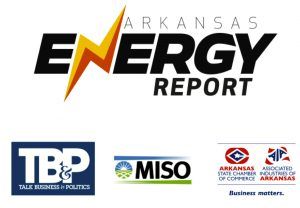Arkansas Energy Report: State severance tax revenue down almost 60%, fuel prices move lower
by August 22, 2016 12:43 pm 193 views

Editor’s note: The Arkansas Energy Report is produced monthly and is sponsored by the Arkansas State Chamber of Commerce/Associated Industries of Arkansas, and MISO (Midcontinent Independent System Operator). Talk Business & Politics makes every effort to use information current at time of posting.
––––––––––––––
The energy sector continues to struggle in Arkansas and nationwide, with state severance tax revenue down almost 60%. But there are some signs of resurgence in the oil and gas industry.
Despite increases in crude oil prices since the start of the year, employment in oil and natural gas extraction and support activities continued declining from levels reached in the fall of 2014, just before the onset of falling oil prices.
The total rig count (including both oil-directed and natural gas-directed rigs) has declined even more sharply, from nearly 1,800 rigs in the fall of 2014 to a weekly low of 404 rigs in May 2016. Crude oil production has also declined, but to a much lesser extent than either employment or rig counts, while natural gas production has leveled.
Employment in oil and natural gas production reached a high of 538,000 jobs in October 2014. Since then, oil and natural gas production employment declined 26%, a loss of more than 142,000 jobs through May 2016, based on the latest jobs data available. The total decrease in production jobs is nearly three times the 51,000 jobs lost over a 13-month period during the 2008-09 recession.
Arkansas severance tax collection for the year ended June 30, 2016, offers a new reality for the state’s maturing natural gas industry, which at one point at the peak of Fayetteville Shale production pushed Arkansas into the nation’s top 10 states for marketed sales of the naturally occurring hydrocarbon.

In the first month of fiscal 2017, which began on July 1, severance collections only amounted to $1.76 million, down nearly 50% from $3.48 million a year ago. That total is less than every month in fiscal 2016 except May and June, the two months preceding the July revenue report.
Following are other items in the August 2016 Arkansas Energy Report.
• As consumers burn their air-conditioner to stay cool during dog days of summer, U.S. spot electricity prices have nearly doubled in most markets as the nation’s top utilities and grid operators have seen a huge surge in power demand.
• The Midcontinent Independent System Operator (MISO), which operates its four-state South region grid operations from its command center in Little Rock, forecasted summer demand to peak at 125.9 gigawatts (GW) and 148.8 GW of capacity will be available to meet demand. This 18.2% percent reserve margin is slightly above MISO’s reserve margin requirement of 15.2%.
• In Arkansas, the state mining and logging sector, which includes the oil and gas sector, lost 1,400 jobs in the past year as all of the Fayetteville Shale developers have pulled up stakes and halted drilling actively.
• According to AAA, the national average price for regular unleaded gasoline is $2.13 per gallon on Aug. 8, which was the lowest price for that date since 2004 and 26 cents below 2016’s peak price to date of $2.40 on June 11. But at $1.94 per gallon on average, Arkansans in every region of the state are finding they can fill up the tank of an average 15- to 16-gallon vehicle for less than $40.
Link here for the PDF of the August 2016 Arkansas Energy Report.
